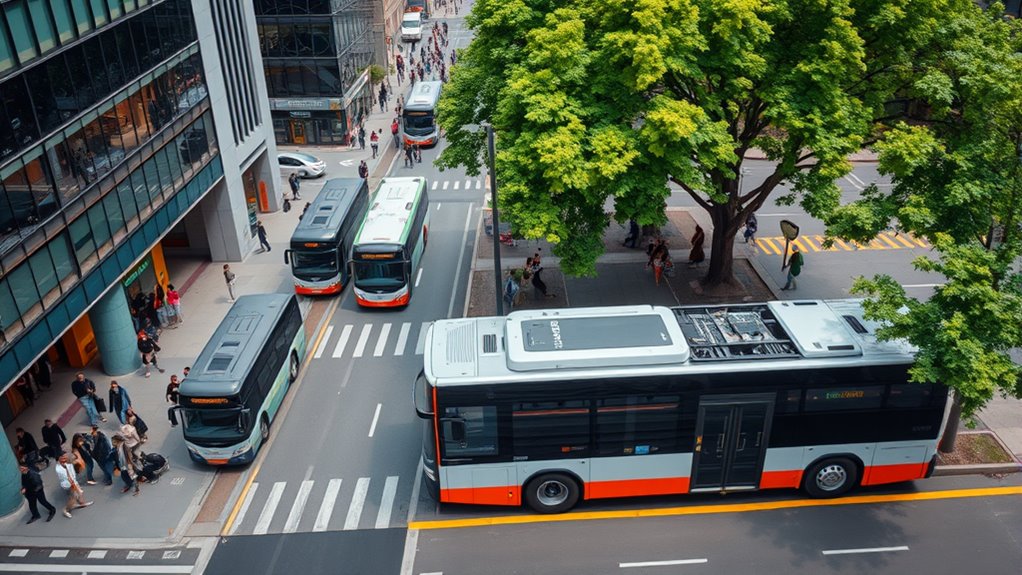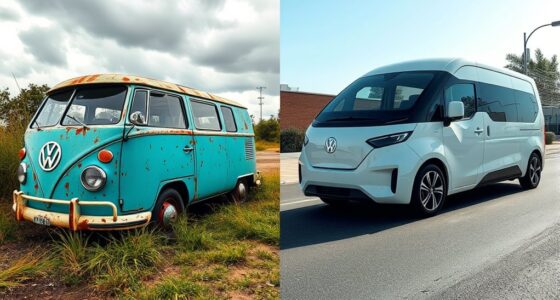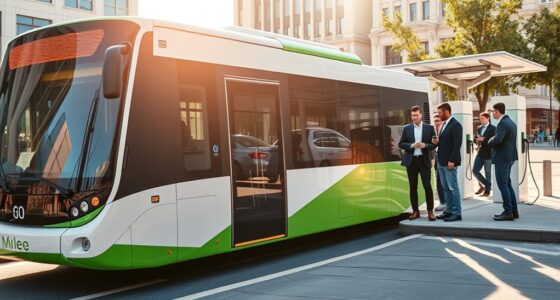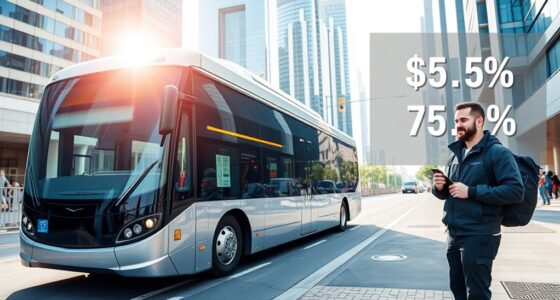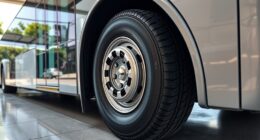Electric buses work best on shorter, urban routes with frequent stops, because regenerative braking captures energy and cuts fuel costs. They need smaller batteries, which lower upfront costs and reduce charging time, making them more cost-effective. For longer routes, larger batteries and more infrastructure are needed, increasing costs. If you want to explore how route types affect overall savings and planning, there’s much more to discover.
Key Takeaways
- Electric buses excel on shorter, urban routes due to regenerative braking and lower energy costs per mile.
- Longer routes require larger batteries and infrastructure, increasing initial costs but reducing operational expenses over time.
- Terrain and climate affect battery efficiency and range, influencing route planning and overall cost-effectiveness.
- Fleet scaling and economies of scale lower per-unit costs, enhancing electric buses’ economic viability across route types.
- Supportive grants and incentives can offset higher upfront investments, improving long-term cost savings for diverse routes.
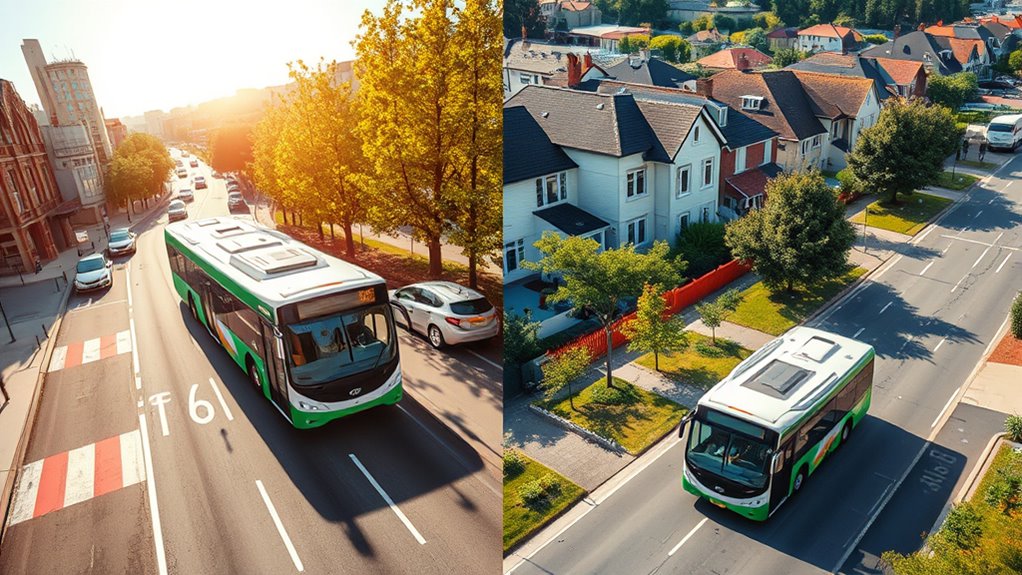
Electric buses are increasingly recognized as a cost-effective alternative to traditional diesel models, thanks to their lower fuel and maintenance costs, environmental benefits, and supportive funding programs. However, the true cost-effectiveness of electric buses depends heavily on route-specific factors, which influence their efficiency and overall savings.
Shorter routes, for instance, tend to be more suitable for electric buses because they require smaller batteries, reducing upfront costs and charging time. If your bus operates mostly within a limited area, you’ll find that electric buses can deliver significant savings over diesel models, especially when factoring in lower fuel costs and reduced maintenance needs. Electric buses consume electricity that’s about 2.5 times cheaper than diesel per mile, and their predictable electricity prices help you budget more reliably than fluctuating fuel markets. Additionally, regenerative braking captures energy during stops, further boosting efficiency on stop-and-go urban routes.
Longer routes pose a different challenge. They demand larger batteries, which increase initial purchase costs and may require more frequent charging or larger infrastructure investments. If your fleet covers extensive distances daily, you need to weigh the extra upfront costs against long-term savings. While larger batteries increase initial expenses, the lower operational costs—less fuel, fewer repairs—can still make electric buses competitive, especially with supportive grants that cover both vehicle and infrastructure costs.
The lifespan of charging infrastructure, assumed to match the bus’s operational life, further influences the total cost picture, making scaling fleets advantageous as larger orders benefit from economies of scale.
Terrain and climate also impact electric bus cost-effectiveness. Hilly terrains demand more energy, reducing range and increasing charging needs, which can add to operational costs. Similarly, extreme temperatures can impair battery efficiency, potentially requiring additional thermal management systems. In such environments, route planning becomes critical to maximize battery life and minimize charging frequency.
Urban routes with frequent stops benefit from regenerative braking, which improves overall efficiency and reduces brake wear, translating into lower maintenance costs and less downtime. Conversely, high-mileage routes with less frequent stops mightn’t see as much benefit from regenerative braking, but still gain from lower fuel and maintenance expenses.
Ultimately, electric buses are most cost-effective on shorter, urban routes where frequent stops, regenerative braking, and predictable operational costs shine. Longer routes can still be viable but require careful planning, larger initial investments, and consideration of terrain and climate factors.
When supported by grants and incentives, electric buses can deliver compelling lifetime savings, making them a smart choice across diverse route types.
Frequently Asked Questions
How Do Electric Buses Impact Local Air Quality in Urban Areas?
You see, electric buses substantially improve local air quality in urban areas. They cut down harmful emissions like nitrogen oxides and particulate matter, which cause respiratory issues.
What Are the Maintenance Differences Between Electric and Diesel Buses?
When comparing maintenance between electric and diesel buses, you’ll find electric buses require less routine work. They don’t need oil changes, brake pad replacements, or exhaust system repairs, saving time and money.
However, you’ll need specialized training for high-voltage systems and monitor battery health over time. Overall, electric buses have fewer moving parts, leading to lower maintenance costs and simplified workflows, but initial investments in safety equipment are necessary.
How Does Passenger Capacity Vary Between Electric and Traditional Buses?
Imagine stepping onto a bus, wondering if electric or traditional models will hold more passengers. You’ll find that both can accommodate around 80 passengers, but electric buses come in various sizes, like 12 or 18 meters.
Larger, articulated electric buses often carry more. So, while their capacities are similar, the size and design of electric buses can be tailored to match or even surpass traditional buses for passenger needs.
Are There Specific Route Features That Maximize Electric Bus Efficiency?
You want to know which route features boost electric bus efficiency. Flat, short routes with minimal stops and steady speeds help maximize range and reduce energy use.
Avoid hilly terrain and extreme temperatures, since they increase consumption. Also, smooth traffic flow and moderate climate conditions make for better performance.
What Incentives or Subsidies Are Available for Electric Bus Adoption?
You might think electric buses are too costly, but numerous incentives make them more affordable. Federal programs like the EPA Clean School Bus Program offer $5 billion for zero-emission replacements.
While tax credits and rebates cut upfront costs. State incentives, such as California’s HVIP, provide vouchers and grants. These financial supports, combined with lower operational costs, help you justify switching to electric buses, especially in pollution-heavy or underserved areas.
Conclusion
Think of electric buses as the sprinters of your city’s transportation race. On short routes, they dash ahead, saving energy and costs, like a swift runner avoiding fatigue. On longer routes, they’re steady, but the race gets tougher, and their advantage narrows. By choosing the right route type, you’re guiding your city’s race toward victory—cost-effective, eco-friendly, and efficient. Embrace the sprinter in your electric fleet, and watch your city run smoothly into the future.
